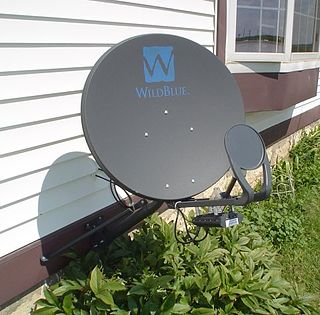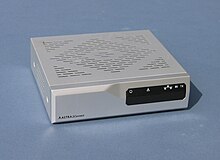
General Packet Radio Service (GPRS), also called 2.5G, is a packet orientated mobile data standard on the 2G cellular communication network's global system for mobile communications (GSM). GPRS was established by European Telecommunications Standards Institute (ETSI) in response to the earlier CDPD and i-mode packet-switched cellular technologies. It is now maintained by the 3rd Generation Partnership Project (3GPP).
The Ku band is the portion of the electromagnetic spectrum in the microwave range of frequencies from 12 to 18 gigahertz (GHz). The symbol is short for "K-under", because it is the lower part of the original NATO K band, which was split into three bands because of the presence of the atmospheric water vapor resonance peak at 22.24 GHz, (1.35 cm) which made the center unusable for long range transmission. In radar applications, it ranges from 12 to 18 GHz according to the formal definition of radar frequency band nomenclature in IEEE Standard 521–2002.

Ultra high frequency (UHF) is the ITU designation for radio frequencies in the range between 300 megahertz (MHz) and 3 gigahertz (GHz), also known as the decimetre band as the wavelengths range from one meter to one tenth of a meter. Radio waves with frequencies above the UHF band fall into the super-high frequency (SHF) or microwave frequency range. Lower frequency signals fall into the VHF or lower bands. UHF radio waves propagate mainly by line of sight; they are blocked by hills and large buildings although the transmission through building walls is strong enough for indoor reception. They are used for television broadcasting, cell phones, satellite communication including GPS, personal radio services including Wi-Fi and Bluetooth, walkie-talkies, cordless phones, satellite phones, and numerous other applications.

A very-small-aperture terminal (VSAT) is a two-way satellite ground station with a dish antenna that is smaller than 3.8 meters. The majority of VSAT antennas range from 75 cm to 1.2 m. Bit rates, in most cases, range from 4 kbit/s up to 16 Mbit/s. VSATs access satellites in geosynchronous orbit or geostationary orbit to relay data from small remote Earth stations (terminals) to other terminals or master Earth station "hubs".
The S band is a designation by the Institute of Electrical and Electronics Engineers (IEEE) for a part of the microwave band of the electromagnetic spectrum covering frequencies from 2 to 4 gigahertz (GHz). Thus it crosses the conventional boundary between the UHF and SHF bands at 3.0 GHz. The S band is used by airport surveillance radar for air traffic control, weather radar, surface ship radar, and some communications satellites, especially those satellites used by NASA to communicate with the Space Shuttle and the International Space Station. The 10 cm radar short-band ranges roughly from 1.55 to 5.2 GHz. The S band also contains the 2.4–2.483 GHz ISM band, widely used for low power unlicensed microwave devices such as cordless phones, wireless headphones (Bluetooth), wireless networking (WiFi), garage door openers, keyless vehicle locks, baby monitors as well as for medical diathermy machines and microwave ovens. India's regional satellite navigation network (IRNSS) broadcasts on 2.483778 to 2.500278 GHz.

Satellite Internet access is Internet access provided through communication satellites; if it can sustain high speeds, it is termed satellite broadband. Modern consumer grade satellite Internet service is typically provided to individual users through geostationary satellites that can offer relatively high data speeds, with newer satellites using the Ku band to achieve downstream data speeds up to 506 Mbit/s. In addition, new satellite internet constellations are being developed in low-earth orbit to enable low-latency internet access from space.
StarBand was a two-way satellite broadband Internet service available in the U.S. from 2000–2015.

The Broadband Global Area Network (BGAN) is a global satellite network with telephony owned by Inmarsat using portable terminals. The terminals are normally used to connect a laptop computer to broadband Internet in remote locations, although as long as line-of-sight to the satellite exists, the terminal can be used anywhere. The value of BGAN terminals is that, unlike other satellite Internet services, which require bulky and heavy satellite dishes to connect, a BGAN terminal is about the size of a laptop and thus can be carried easily. The network is provided by Inmarsat and uses three geostationary satellites called I-4 to provide almost global coverage.
Thuraya is a United Arab Emirates-based regional mobile-satellite service (MSS) provider. The company operates two geosynchronous satellites and provides telecommunications coverage in more than 161 countries in Europe, the Middle East, North, Central and East Africa, Asia and Australia. Thuraya's L-band network delivers voice and data services.
In telecommunications, cable Internet access, shortened to cable Internet, is a form of broadband internet access which uses the same infrastructure as cable television. Like digital subscriber line and fiber to the premises services, cable Internet access provides network edge connectivity from the Internet service provider to an end user. It is integrated into the cable television infrastructure analogously to DSL which uses the existing telephone network. Cable TV networks and telecommunications networks are the two predominant forms of residential Internet access. Recently, both have seen increased competition from fiber deployments, wireless, mobile networks and satellite internet access.
Astra 1E is one of the Astra communications satellites in geostationary orbit owned and operated by SES. It was launched in October 1995 to the Astra 19.2°E orbital slot initially to provide digital television and radio for direct-to-home (DTH) across Europe.

Inmarsat is a British satellite telecommunications company, offering global mobile services. It provides telephone and data services to users worldwide, via portable or mobile terminals which communicate with ground stations through fifteen geostationary telecommunications satellites.
DVB-RCS provides a method by which the DVB-S platform can become a bi-directional, asymmetric data path using wireless between broadcasters and customers. It is a specification for an interactive on-demand multimedia satellite communication system formulated in 1999 by the DVB consortium. Without this method, various degrees of interactivity can be offered, without implying any return channel back from the user to the service provider: Data Carrousel or Electronic Programs Guides (EPG) are examples of such enhanced TV services which make use of “local interactivity”, without any return path from customer to provider.
The prevalent means of connecting to the Internet in Germany is DSL, introduced by Deutsche Telekom in 1999. Other technologies such as Cable, FTTH and FTTB (fiber), Satellite, UMTS/HSDPA (mobile) and LTE are available as alternatives.
SES Broadband is a two-way satellite broadband Internet service available across Europe, which launched in March 2007, and uses the Astra series of geostationary satellites.
FleetBroadband is maritime satellite internet, telephony, SMS texting, and ISDN network for ocean-going vessels using portable domed terminal antennas.

Tooway is a satellite broadband Internet service available across Europe. The first version of the service was launched in 2007 via two Eutelsat geostationary satellites, Hot Bird 6 and Eurobird 3, respectively at the 13° and 33° East orbital positions.
Astra 3B is one of the Astra communications satellites owned and operated by SES, launched in 2010 to the Astra 23.5°E orbital position providing digital television and radio for direct-to-home (DTH), and the AstraConnect two-way satellite broadband services across Europe and the Middle East.
SwiftBroadband is an IP-based packet-switched communications network that provides a symmetric ‘always-on’ data connection of up to 650 kbit/s per channel for aircraft globally except for the polar regions, using the Inmarsat satellite constellation.

Es'hail 2 is a Qatari satellite, launched aboard a SpaceX Falcon 9 rocket on November 15, 2018. Es'hail 2 was built by Japan's Mitsubishi Electric company, and operates at 26° East longitude along a geostationary orbit to provide direct-to-home television services in the Middle East and North Africa region. The satellite features 24 Ku-band and 11 Ka-band transponders to provide direct broadcasting services for television, government and commercial content distribution. In addition to commercial services, the payload of Es'hail 2 includes a linear transponder with a bandwidth of 500 kHz and 8 MHz for the amateur radio satellite service, with uplink on 2.4 GHz and downlink on 10.45 GHz.









